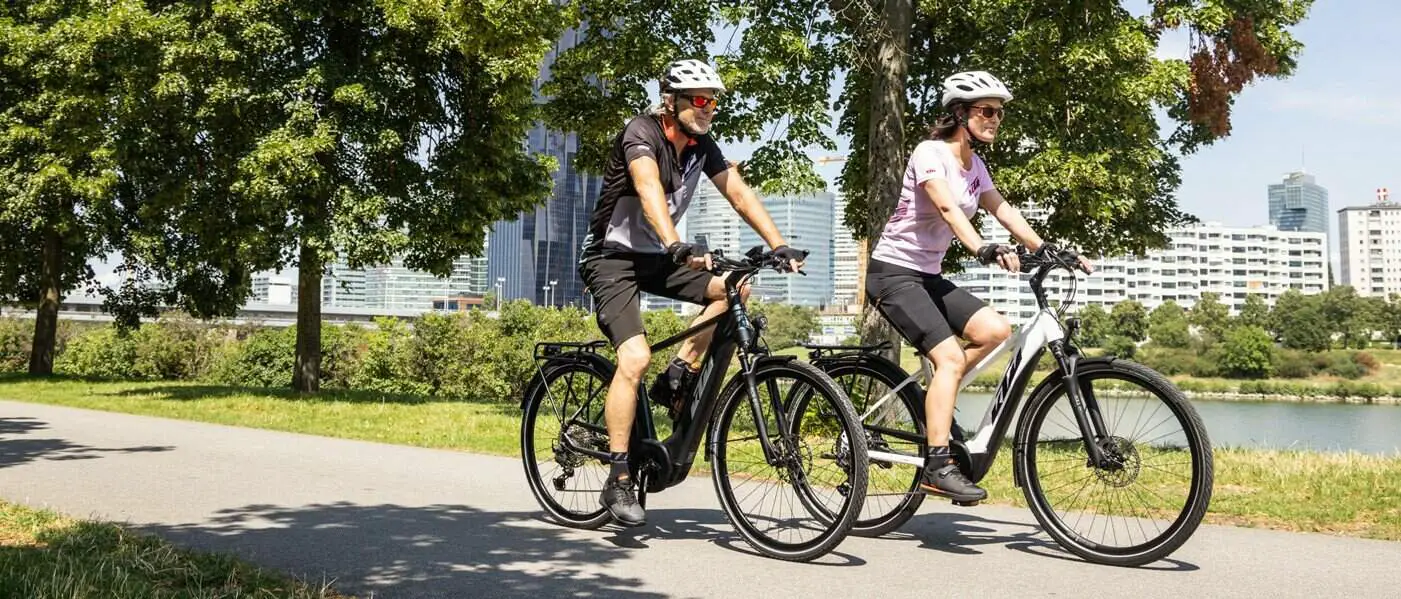Last Updated on June 2, 2022 by Igor Karni

As we get older, it is inevitable that our bodily functions begin to decline (source), making once feasible physical activities much harder and riskier to do. The barriers associated with aging can also make it difficult to navigate what types of activities are accessible, and which are not.
So the question inevitably comes up: is riding an e-Bike risky for elderly riders?
While there certainly are a number of risks associated with e-Cycling, this article will primarily pinpoint those risks and address how they can be mitigated, avoided, and even managed.
Senior e-bike rider risk factors
With a huge increase of elderly riders turning to cycling in the last few decades, there’s no doubt why the electric assistance feature of e-Bikes is a huge draw for older riders. This is because riding an e-Bike is considerably less strenuous than a traditional bicycle since the level of electric assistance can be adjusted so that less human power is needed during a ride.
Especially for elderly people dealing with physical conditions like arthritis, muscle loss, joint replacements, brittle bones, and other barriers often associated with aging, e-Biking is an ideal option for physical activity.
However, older riders should be sure to assess the risks associated with e-biking before starting up an e-bike regime.

Some common risks (source) that are unfortunately linked to older age, which can have a negative impact on e-cycling rides, are these.
First, poor vision can increase the chance of falls at nighttime, can make it difficult to observe traffic and important signs, and can make it hard to adapt to changing traffic conditions.
Second, reduced muscle strength in the elderly can lead to poor balance on one’s e-Bike, increased chance of falling, and instability when it comes to operating and steering the vehicle.
Lastly, declining cognition can also lead to poor road judgment, can increase the chances of becoming lost on route, and may lead to the inability to understand traffic signals.
A few other risks to keep in mind, according to statistics taken by Allianz (source):
- Every tenth cyclist killed in a traffic accident rides a pedelec (pedal-assist e-Bike)
- Eight out of every ten traffic fatalities are over the age of 65
Read also: Are electric bikes dangerous? What are e-bike risks? And, How safe are electric bikes?
Allianz also warns riders to be wary of “flying e-Bikes”, noting that standard bicycle racks are not suitable for transporting e-Bikes (since the motor, frame, and battery of an e-Bike adds quite a bit more weight onto the vehicle).
U.S. studies taken by Smart Growth America have shown that older people also have a higher likelihood of being injured or killed in traffic, likely linked to the above risk factors (source).
However, this should not deter you from riding your e-Bike: once the risks are properly considered and necessary precautions are taken (which will be explored further below), it is important to remember that e-Biking is a great tool for improving one’s physical and mental health, and can be used safely.
How to mitigate e-biking risks for senior riders?
So what are some ways that elderly riders can address these risks and issues?

When it comes to vision and cognitive functions, it’s a good idea to consult your healthcare practitioner to undergo any necessary tests to determine whether it is safe for you to maneuver an e-Bike. There are also many activities a person can do to help improve cognition, as well, such as meditation, brain-training games, and proper sleep. (Here is a list from Healthline (source) which outlines some brain strengthening exercises one can do!)
Next, it is important to find an electric bicycle that works best for your physical needs. If you are worried about stability and balance, for example, you can reduce the risk of falling on your ride by considering a few different options.
One good option is the step-through frame e-Bike. This type of e-Bike allows you to quite literally step through the frame since it does not have a top bar. This is particularly effective for riders with limited mobility or other mobility problems (ie. hip, knee, and balance issues), as this means you can get seated on your e-Bike effortlessly, ultimately reducing the risk of falling when getting on and off the e-Bike.
Read also: How to select the best e-trike (with examples)? And, How much does a good e-trike cost?
Another consideration is to invest in an e-Tricycle, which has three wheels instead of the two that an e-Bicycle has. E-Trikes tend to have more relaxed seated positions as well, as they are more upright, which may be more comfortable for riders who deal with back problems.
E-Trikes have been proven to be a great option for elderly riders who are worried about their balance while riding. Considering options like the step-through frame and e-Trike can significantly reduce the risk of falling, instability, and other related injuries. E-Trikes are also great for making hills easier to ride on, providing more overall support than e-Bikes and thus decreasing the risk of injury or overexertion.
To address the issue of weakened strength and muscles, one should remember that introducing an activity like e-Cycling into an older person’s life, who are often sedentary due to many exercises being otherwise too strenuous, can inevitably help to strengthen the body and improve overall fitness. However, older riders should start off with light e-Bike rides, and only build up intensity and mileage slowly.
Read also: Does riding an e-bike help train strength and endurance? And, Are electric bikes good for cardio exercise?
One should rely as much as possible on the pedal-assist feature, adjusting as necessary, as the reliance on electric power will make the riding process much easier than many other forms of exercise. However, because of this feature, this makes the speed of e-Bikes faster as well, so riders should be wary of this when riding. Consider going on a test ride in a low-traffic area first, to test out your ability to start and stop safely and efficiently.
If you are dealing with any vision-related issues, ensure that you ride only throughout the day when there is sufficient light, so as to lower the risk of reduced visibility at night. Riders should also make sure they are wearing bright or reflective clothing in order to be clearly visible to other vehicles on the road.

Older riders should also be wary of extreme weather conditions like rain, ice, or snow, and should avoid riding in these conditions altogether to decrease the risk of injury (since these weather conditions can cause poor visibility and an increased chance of slipping and falling).
E-Bike riders should also ensure that their e-Bikes are properly serviced before riding, in order to ensure that the brakes, positioning, and other important functions are safely in effect. The best way to do this is to visit your local e-Bike shop and consult a professional.
The benefits of riding an e-bike for seniors
It is not difficult to find various personal stories and studies showcasing elderly riders whose lives have been changed for the better through e-Biking. As mentioned earlier, many older people are otherwise quite limited in terms of the physical activities they are able to do.
However, staying sedentary can be detrimental to one’s health, and can contribute to further health problems and complications. So ultimately, doing nothing at all in terms of physical activity is a lose-lose situation, since staying active is one of the best things one can do to prevent further health deterioration (and can even help to manage current conditions).
Read also: Are electric bikes cheating (backed by research)? And, Are electric bikes good for fitness?
Therefore, e-Bikes are a great solution and option for those looking to find a safe and light exercise that will still benefit their fitness. Not only that, but providing a method of transportation to the elderly brings forth a sense of freedom and mobility that is often taken away from many (especially when the option to drive or walk long distances is no longer an option).
And consider this: even for those of you who are still able to drive a car, that’s still a sedentary activity, so e-Biking can introduce some much-needed activity into your life regardless! Many riders even remark that they can go grocery shopping (with an adequate basket, of course) with their e-Bikes, bringing simple pleasures back into their lives.
Because of factors like these, a large number of elderly riders have noted that e-biking has helped them lead to happier lives, a better quality of life, and improved mental health, as well as improved longevity in many cases.
Ultimately, e-Bikes are a low-impact exercise option and are widely recommended for anyone dealing with any type of physical barrier, whether age-related or not.
The many accounts of riders dealing with hip replacements, arthritis, heart disease, and various other barriers in conjunction with old age who have found a new way of life in e-biking are extremely encouraging, and help to further showcase how reliable an option e-Biking is for senior riders.
So long as one carefully observes all of the risks and addresses them accordingly, e-Bikes are an effective and overall safe option for physical activity!
Read also: Ever considered offering e-bike as a gift? Or gifting one to yourself? Check out our suggestions – in this e-bike gift guide.
Igor is a sustainable mobility and green energy advocate. His mission for Easy E-biking is to help make electric cycling simple, practical, and fun. Follow him on Facebook and LinkedIn.




